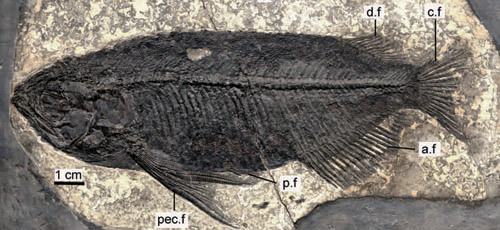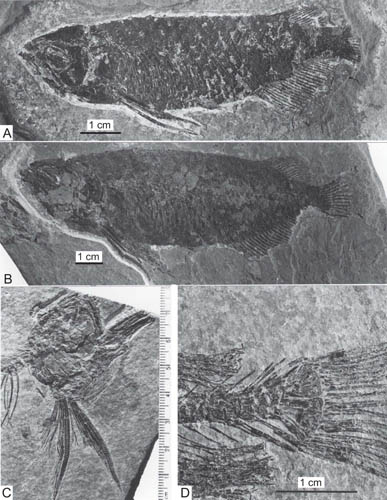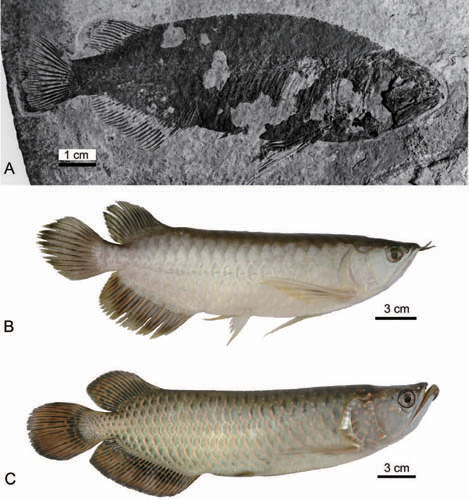The Origins of the Dragon Fish (Scleropages)
Scientists from the Institute of Vertebrate Palaeontology and Palaeoanthropology (IVPP) have published details of the discovery of beautifully preserved fish fossils from China that have helped map the origins of one of the most valuable and sought after aquarium fishes in the world. Scleropages formosus, the Asian Arowana, otherwise known as the Dragon Fish from south-eastern Asia, quite rare in the wild these days, but it is highly regarded amongst freshwater aquarium owners, who can splash out thousands of dollars to acquire particularly colourful specimens.
Scleropages sinensis
In a scientific paper published in the journal “Vertebrata PalAsiatica”, Dr Zhang Jiangyong (IVPP) in collaboration with Dr Mark Wilson (University of Alberta), report on the discovery of a new species of osteoglossid fish from the Early Eocene Xiwanpu Formation in Hunan and the Yangxi Formation in Hubei, (China). The prehistoric fish is remarkable similar to the extant species and it has been named Scleropages sinensis (the name translates as “hard scaled leaves from China”, a reference to the robust tough body scales that characterises these fish).
The Holotype Fossil Material of Scleropages sinensis
Picture credit: Zhang Jiangyong (IVPP)
The picture above shows the beautifully preserved holotype specimen of S. sinensis. The fins are labelled (df) = dorsal fin, (cf) = caudal fin, (af) = anal fin, (pf and pec f) = pectoral fins, scale bar 1 centimetre.
An Almost Complete Body Fossil
This is the first time a nearly complete body fossil of this genus has been described. Previously, the fossil record only consisted of individual scales, otoliths (calcified structures from the inner ear) and isolated fragmentary bones. The discovery of Scleropages sinensis dates the divergence of Scleropages from the closely related Osteoglossum to at least as far back as the Early Eocene. The fish fossils represent a number of different ontogenetic (growth stages). The largest specimens are 17.5 centimetres in length, the smallest under 8 centimetres long.
Fossil Scleropages are known from the Maastrichtian of India, the Maastrichtian/Late Palaeocene of Africa, the Palaeocene of Europe, the Eocene of Sumatra, and the Oligocene of Australia. All of these earlier records are scales, otoliths and isolated bone fragments. Therefore, these newly described Chinese fossils are the first skeletons of fossil Scleropages ever unearthed in the world.
Views of the Scleropages Fossil Material
Picture credit: Zhang Jiangyong (IVPP)
Dr Zhang stated:
“This new fish resembles Scleropages in skull bones, caudal skeleton, the shape and position of fins, and reticulate scales. Therefore, it must belong to the genus.”
Studying Extant Species
The extant species of Scleropages inhabits lakes, swamps and flooded forests as well as slowly meandering rivers. It is a carnivorous fish preying on insects, worms, small amphibians, other fish, small mammals and even birds. The fish is renowned for its jumping, the researchers propose that Scleropages sinensis may have filled a similar niche in the Eocene ecosystem, but being smaller it probably had a more restricted diet than its extant relative. Analysis of the fossil material suggests that sexual dimorphism may have existed in S. sinensis.
Comparing the Extinct Species with Living Species
Picture credit: Zhang Jiangyong (IVPP)
The Everything Dinosaur website: Everything Dinosaur.









Leave A Comment